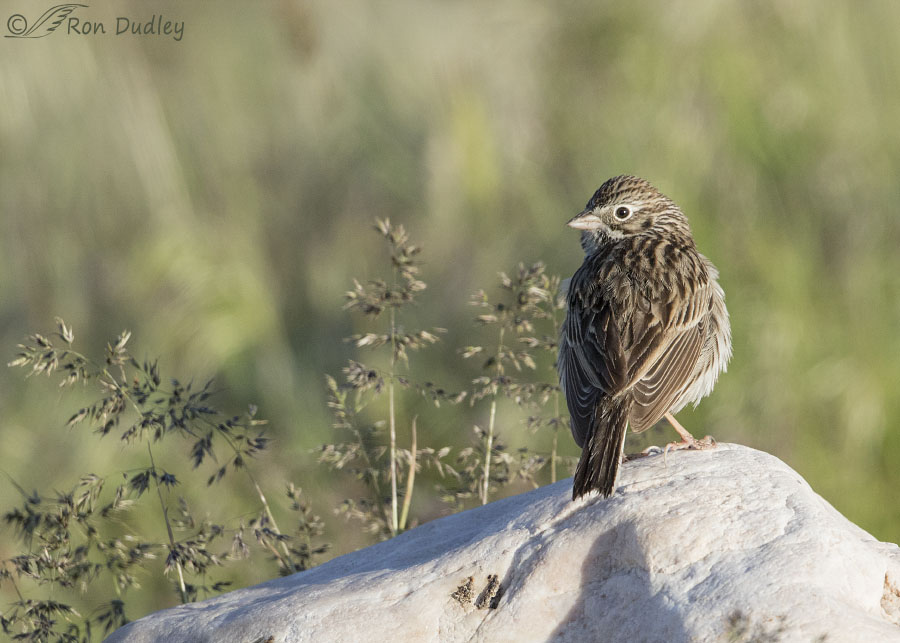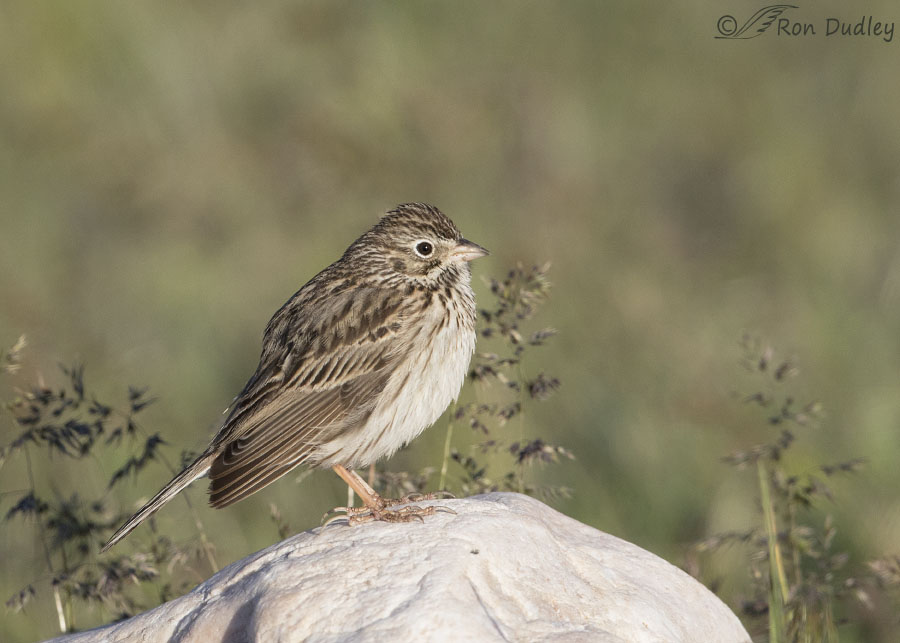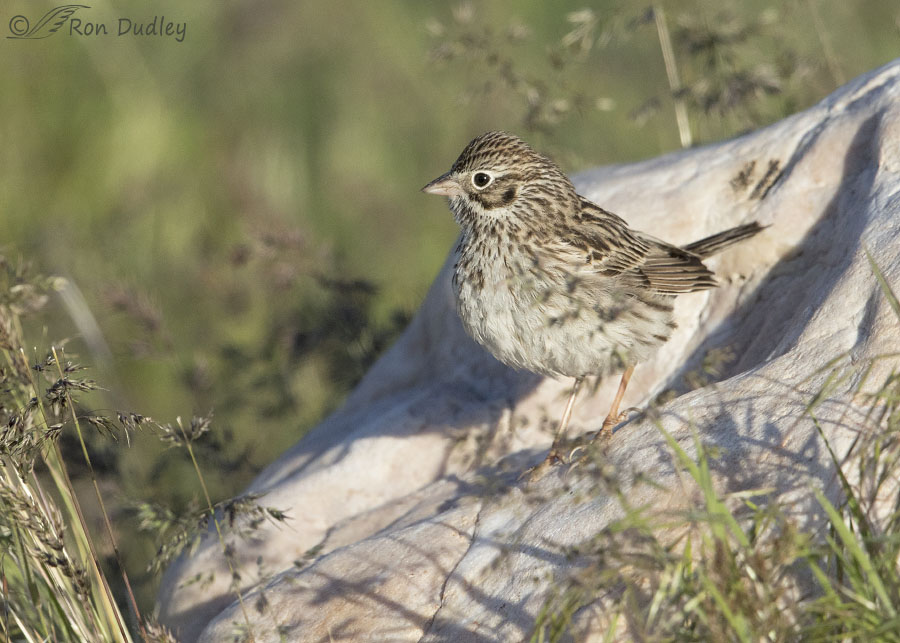LBJ’s (little brown jobs) don’t get enough attention from bird photographers, including me on Feathered Photography, so this post is part of my effort to rectify the situation.

1/2000, f/6.3, ISO 800, Canon 7D Mark II, Canon EF 500mm f/4L IS II USM + EF 1.4 III Extender, not baited, set up or called in
I photographed this Vesper Sparrow 11 days ago on Antelope Island while it was perched on a Tintic Quartzite boulder – the most dominant type of rock on the north end of the island. Tintic Quartzite is white so it’s very difficult to expose properly in bright light but these photos were taken early enough in the morning that I was able to get a good exposure on the bird without blowing out the whites of the boulder.

1/3200, f/6.3, ISO 800, Canon 7D Mark II, Canon EF 500mm f/4L IS II USM + EF 1.4 III Extender, not baited, set up or called in
Soon after I moved a little closer to the sparrow it turned to give me more even light on its entire body.

1/5000, f/5.6, ISO 800, Canon 7D Mark II, Canon EF 500mm f/4L IS II USM + EF 1.4 III Extender, not baited, set up or called in
When it decided to leave the boulder it chose to follow a natural ramp or chute in the rock down to the ground. Here it paused for a moment which allowed me a few photos before it continued on its way. Immediately after this shot was taken it disappeared into the grasses at lower left.
When I encounter a somewhat unusual common name for a bird like “Vesper Sparrow” I often do some research to satisfy my curiosity about its origin. “Vespers” of course are religious services of prayer and hymns held in many western Christian churches in the evenings but what does that have to do with this sparrow?
- Through the early 1800’s this bird was called the Bay-winged Bunting or Grass Finch but in an 1858 essay in the Atlantic Monthly naturalist Wilson Flagg wrote that these sparrows sang in the evening “with still greater zeal than they chanted in the morning”. For that reason Flagg thought that Vesper Sparrow would be an appropriate name but his influence was minimal so at first the name didn’t change.
- But by 1865 Flagg’s suggestion caught the attention of rising superstar in the naturalist world John Burroughs and he liked the name Vesper Sparrow, writing (once again in the Atlantic Monthly) that this little sparrow’s “song is most noticeable after sundown, when other birds are silent; for which reason he has been aptly called the vesper sparrow”.
- Because of Burroughs’s popularity and influence, when the American Ornithologist’s Union published its first bird checklist in 1886 they called it the Vesper Sparrow. That checklist was the first standardization of the common names of North American birds so the name stuck. That has been its name ever since.
I know, I’ve devoted a lot of time and effort here to “trivia” but to many of us who love birds, trivia matters.
Ron
Note: If you have the interest the song and calls of the Vesper Sparrow can be heard (and seen) here.


I’ve never heard of this cute bird so having the history of how it got its name is a extra bonus This why I’m so happy to have found your blog. To discover new birds, your stories and how you captured the picture
This why I’m so happy to have found your blog. To discover new birds, your stories and how you captured the picture 
Hope you’re having a great day
“This why I’m so happy to have found your blog.”
And I’m delighted to have you here, Diana. Thank you.
What a lovely LBJ! I agree with everyone else with the interesting trivia–it’s just SO interesting. And you never know when that tidbit of information will come in handy to amaze your birdy friends OR to bore and annoy your non-birdy friends so that they walk away and you can get back to your birding again…LOL!! It might even come in handy when you get on “Who Wants to be a Millionaire!”
Seriously, thanks for bringing this beauty this morning!
I’m delighted to hear that the trivia didn’t bore everyone to tears, Laura – if they were able to wade through it at all.
My ever-loving family puts my fascination with trivia (on selected subjects) down to small things for a small mind. Birds (and their naming conventions) fall very firmly into that selected subjects list. And as you know I love the muted melochrome magic of lbjs.
I’m in the same camp, EC. I think my favorite board game ever was Trivial Pursuits.
The Vesper Sparrow is a beautiful bird. I really like seeing the photos with the bright rock where both the rock and the bird look very good (I am expert at blowing out bright things like the boulder). I really like the LBJ’s – they always have beautiful feather patterns, if one pays attention to those details.
“I really like the LBJ’s – they always have beautiful feather patterns, if one pays attention to those details.”
That’s right, Susan – they very often do.
I don’t know what it us about these LBJ’s, I can’t usually tell one from another, but seeing them around always gives me a sense of security. Live these images and the big rock perch.
Yes, it’s comforting to have LBJ’s around, isn’t it, Patty.
Thanks for the vesper info – I had wondered if there was a link to evening vespers and now I know. Although I do like the grass finch name also! Gorgeous clear pictures. Lovely!
And now we ALL know, Beth Ann. Thanks.
Hi Ron,
The Vesper Sparrow is (one of my) harbingers of spring here in southern OR. Love the song. And, just in case it pops up on Jeopardy!, our local population, the “Oregon” Vesper Sparrow (slightly smaller than the “Western”), is considered by some scientists to be a separate subspecies. Definitely “upper division stuff”…
Cheers,
Dick
Nothing wrong with upper division, Dick. That’s where things can get really interesting.
What a fun little bird to see this morning! Thank you for sharing the interesting trivia and it’s beautiful song. Definitely a case of “not what you know but who you know!”
Thank you, Marty. Yup, too often it depends on who you know…
I love the “trivia”–like the origin of the name of this lovely little bird. The 3rd image enchanted me, because of the lacy grass shadows on the boulder–I thought that they were
a nice echo of the sparrow’s subtle coloring and marks . The recording of its song charmed both me and my cat , who was perched on my computer desk–I’ve never seen her
react like that to a recording ! And of course, she’s a strictly indoor appreciator of birds !
Thanks, Kris. That 3rd shot is my favorite of the 3. Happy to hear she’s an indoor cat…
Aah Trivia, how boring life would be without trivia, especially ornithological trivia. Love it!!
Man, that eye ring stands out in your shots.
My first and only sighting of a Vesper Sparrow was at Fort Drum, New York. Funny how life bird sightings stick with you forever.
Here in the ‘East’ schools used to have ‘Vespers’ every Sunday night, or I should say back in the day when I was a teenager in school. Not sure they still do today.
Thanks for sharing.
Yes, they’re known for that white eye ring, Dick. But then some other birds are too…
The little odd tidbits is what makes birding so interesting! I too tend to search out all sorts of info on what I am photographing; smart phones are a great time passer as you wait. As a side note…I was blest with the Vesper’s serenade last evening I sat at the marsh for 2 hours waiting for an American Bittern to make his entrance from the grasses. (I thought I spotted one the day before) Not only was there one but three but the prize was a Least Bittern! I was just catching glimpses of it as it moved from grass to grass but was it frightened down when a truck came roaring down the road makes ‘rooster tails’ in the water. Should be a law…
As a side note…I was blest with the Vesper’s serenade last evening I sat at the marsh for 2 hours waiting for an American Bittern to make his entrance from the grasses. (I thought I spotted one the day before) Not only was there one but three but the prize was a Least Bittern! I was just catching glimpses of it as it moved from grass to grass but was it frightened down when a truck came roaring down the road makes ‘rooster tails’ in the water. Should be a law…
Don’t you hate it when jerks do stuff like that!
Bitterns of either species can certainly be worth the long wait.
I wondered where the name came from – now I know! They are an innocuous LBJ easily over looked for sure
They are an innocuous LBJ easily over looked for sure  The “tidbits” help with remembering the bird for sure. The tintic quartzite certainly could raise hell with exposure!
The “tidbits” help with remembering the bird for sure. The tintic quartzite certainly could raise hell with exposure!
Those rocks are a bugger to expose, Judy. A little later in the morning I often pass up birds perched on them because I know I have no chance to avoid blowing out those whites.
I love trivia and when I lead bird trips for the Denver Field Ornithologists I like to insert a few tidbits of it when verifying bird ID’s to the group. It seems to be a fun thing to do and makes the birds appearance a more interesting occurrence. As Always – Great Birding.
I agree, Mark. All the “little things” can add up to an interesting whole when presenting to others about birds (which, after all, is what I’m doing here).